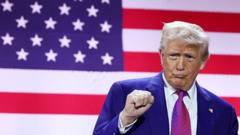As President Trump re-engages with G7 leaders, the landscape of international relations reflects deeper rifts and a challenging trade environment, exacerbated by his self-imposed deadlines for new trade deals.
Trump Returns to G7 Amid Trade Tensions and Alliances Strained

Trump Returns to G7 Amid Trade Tensions and Alliances Strained
The president's return to the G7 signifies an escalation in trade disputes and a noticeable shift in America's international engagement.
Former President Trump's resurgence at the upcoming G7 summit in Alberta brings forth intense scrutiny regarding his relationship with allied nations and the global economic stage. In 2018, during his last participation, Trump diverged significantly from traditional diplomatic pathways by suggesting that Western nations should reintegrate Russia into the group, a stance that alienated many allies.
Now, with increasing tensions, Trump's approach seems even more confrontational as he aims to reduce America's military footprint worldwide while simultaneously escalating trade wars. As he heads into the summit, he faces a pressing deadline of early July to finalize trade agreements. Enticing reports from his trade adviser have suggested aspirations for "90 deals in 90 days," yet progress has been inconsistent, despite initial frameworks established with partners like Britain and China.
Legal challenges surrounding his tariffs cast a shadow on the future effectiveness of this strategy. Market reactions to potential failure in negotiations might provoke a radical increase in tariffs, a prospect Trump himself acknowledges could disrupt the economy. “I think we’ll have a few new trade deals,” he commented confidently, though critics remain skeptical given the administration's historical challenges in diplomatic negotiations.
Thus, the G7 meeting will serve as a critical crossroads for Trump, magnifying the fragile state of global alliances while offering a platform to redefine America's approach to international trade and military commitments.





















